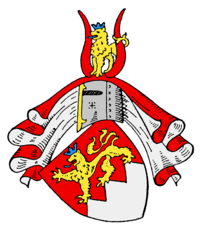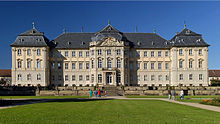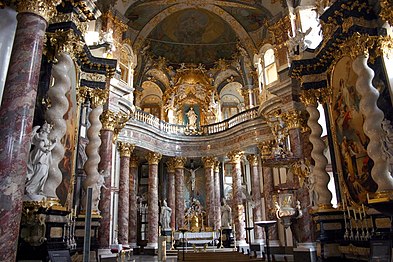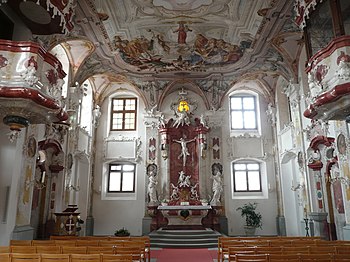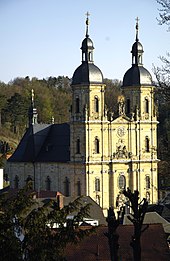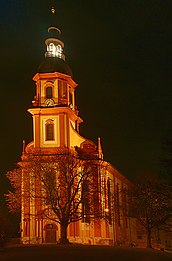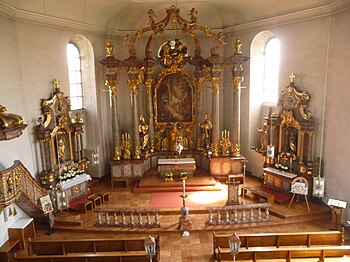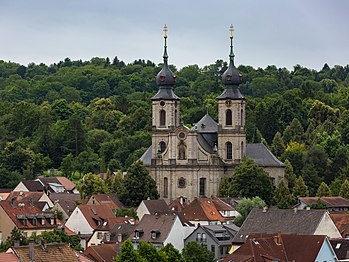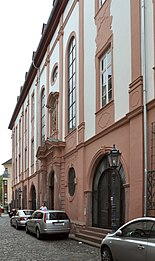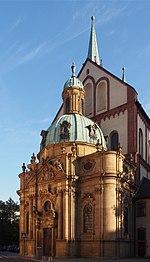Schönborn (noble family)
The family of the Counts of Schönborn is a noble family that has survived to this day , originally from the Rheingau and Taunus , and in the early modern period provided many ecclesiastical dignitaries of the Holy Roman Empire . The Schönborn, especially their church princes , are among the most important builders of the Baroque period in southern Germany.
From 1661 the family held the rule of Heusenstamm in southern Hesse and from 1671 the Würzburg feudal rule Reichelsberg . From 1701 the Schönborn ruled the imperial direct rule Wiesentheid in Lower Franconia, whereby they rose to the high nobility . At the same time as Wiesentheid, rulers in Styria and Carinthia were inherited and soon afterwards through purchase in Lower Austria , from 1726 also in Hungary and towards the end of the 18th century in Bohemia .
Since the 18th century and in art history, the artistic creation in the Hochstift Würzburg between the accession of Prince-Bishop Johann Philipp Franz (1719) and the death of Prince-Bishop Friedrich Karl von Schönberg (1746) has been referred to as Schönborn time . The construction of the Würzburg Residence in particular fell into this era .
origin
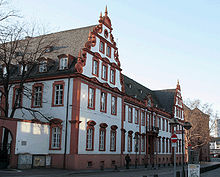
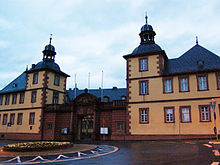






The family traces its origins back to a ministerial family that belonged to the Rhenish knighthood before 1180 . The family's home country was in the Rheingau (western Hintertaunus ) and in eastern Hintertaunus . The family's name is derived from the town of Schönborn near Limburg an der Lahn . The first known bearer of this name is said to have been a knight named Eucharius von Schönborn , who is said to have lived in the middle of the 12th century. However, this Eucharius is only mentioned in a secondary source from around 1670. The family first appeared in a document in 1275 with H. von Sconenburne when it was enfeoffed . It is possible that the early ancestors of the family were tied to the lords of the Schaumburg as vassals , but their coat of arms also suggests a connection to the Counts of Diez .
Early possessions
At the end of the 14th century, the Schönborn had split into three lines , of which the "Stroß" was soon extinguished. The older line kept the headquarters of Schönborn (near Katzenelnbogen ) and, as the most important fiefdom, Burgschwalbach with the Katzenelnbog official castle Schwalbach and the Nassau Hahnstätten . Her relatives appear several times as holders of offices for the counties of Katzenelnbogen and Kurmainz . In addition, there is already an accumulation of ecclesiastical dignities: several abbots, a large bailiff of the Order of St. John and, from the 16th century, canons in Trier and Mainz . The third line was a property focal point in the Westerwald . The Westerwald Schönborn were in the service of the Westerburg , Kurtrier , Kurmainz, Nassau-Weilburg and the County of Wied . Two sub-lines of the Westerwald formed in Laubuseschbach and Freienfels . Numerous documents prove the continued close connections between the two remaining lines, which continued until the older Hahnstätter line with the Mainz canon Friedrich Georg died in 1640.
Schönborn (Rhein-Lahn-Kreis) , headquarters
Schwalbach Castle (Rhein-Lahn district)
Schönborn'scher Hof in Laubuseschbach , Central Hesse
Freienfels Castle , Hesse
Spread
The Schönborn family lived in their home area until the middle of the 17th century. At this time, the Reformation spread in the Hintertaunus, while many family members continued to be Catholic, as the Schönborn traditionally placed younger sons in cathedral monasteries. The family started their ascent with Johann Philipp von Schönborn , who started with a small canon priest in Würzburg at the beginning of the Thirty Years War , then served as an officer and was elected Prince-Bishop of Würzburg in 1642 because of his diplomatic skills . As such, he played a major role in the negotiations at the peace congresses in Münster and Osnabrück and was therefore elected Archbishop and Elector of Mainz in 1647. His brother Philipp Erwein von Schönborn also left his home and was employed as the Electorate of Mainz in Steinheim . He acquired lands and goods on both sides of the Rhine, on the Main and in the Taunus, including Gaibach in 1650 through inheritance, purchase and lending . He bought the Heusenstamm lordship with the goods belonging to it in the Wetterau in 1661. As early as 1663, Emperor Leopold I appointed him and all his descendants to be noble lords and imperial free . At the same time he was given the great palatinate and extensive privileges. His brother also appointed him to Erbschenken the archbishopric Mainz and Erb Stewards of the Bishopric of Würzburg . He also held the titles of Reichshofrat and Electorate Mainz Privy Council . In 1671 the family was accepted into the Franconian knight circle because of the Reichelsberg rule .
In 1635, Philipp Erwein married Freiin Maria Ursula von Greiffenclau-Vollraths (a close relative of the then Mainz Elector Archbishop Georg Friedrich von Greiffenclau zu Vollrads ), with whom he had 12 children, including Lothar Franz , who became Elector and Archbishop of Mainz in 1695, and Melchior Friedrich Graf von Schönborn-Buchheim . Melchior Friedrich inherited the Heusenstamm lordship . He was the imperial and Electorate of Mainz secret councilor and vice domus of Aschaffenburg , married to Sophie Freiin von Boineburg , and lived in the Schönborn court in Aschaffenburg.
As Elector of Mainz and Arch Chancellor of Mainz, Lothar Franz played an important role in imperial politics. He was one of the reliable pillars of Emperor Charles VI. , whom he had elected and also crowned in 1711. When the emperor put down the rebellion of the Magyar Prince Franz II Rákóczi in the Kingdom of Hungary in the same year , he confiscated his lands around Palanok Castle with the cities of Mukachevo and Tschynadijowo as well as 200 villages with a total area of 2,400 square kilometers and gave them to Lothar Franz von Schönborn . He had ordered his Schönborn regiment from Mainz and the Wolfskehl regiment from Würzburg to the Hungarian front, which had made a decisive contribution to the victory. Lothar Franz wanted to cultivate the land that had been destroyed by the war and used tempting offers to attract settlers from Franconia. It was one of the largest estates in Eastern Europe, which the family owned until the 20th century.
Melchior Friedrich had a number of sons, Rudolf Franz Erwein (1677–1754) inherited Gaibach and the palace in Aschaffenburg. Through his marriage to the widowed Countess Eleonore von Dernbach , née Countess von Hatzfeld , the property of the Grafschaft Wiesentheid in Lower Franconia came in 1701 (until today) as well as the rule Arnfels in Styria (until 1912) and the rule Waldenstein in Carinthia (until 1803) to the Schönborn. The countess had inherited these properties from her first husband.
Rudolf's younger brother Anselm Franz (1681–1726) inherited Heusenstamm, which fell to the Wiesentheider branch from his descendants at the beginning of the 19th century. The other four sons of Melchior Friedrich became Prince-Bishops with large sources of income: Johann Philipp in Würzburg, Friedrich Karl in Würzburg and Bamberg, Franz Georg in Trier and Worms and Damian Hugo in Speyer and Constance.
Friedrich Karl spent most of his life in Vienna, where his uncle Lothar Franz had appointed him as Reich Vice Chancellor and he exercised considerable influence at the court, even after he was elected Prince-Bishop of Bamberg and Würzburg. He was also active as a builder in Vienna and acquired several palaces and country estates, including in 1710 the lords of Göllersdorf , Mühlberg and Aspersdorf (with which his father was initially nominally enfeoffed) and in 1714 from the Counts of Puchheim (or Buchheim, who died soon afterwards) the rule of Weyerburg . The family was then accepted into the Austrian nobility . In 1727 he inherited the Pommersfelden Castle and the Hungarian possessions from his uncle Lothar Franz. However, he did not succeed in being elected Archbishop of Mainz as his successor.
At the end of the 18th century, three brothers, great-grandson Rudolf Franz Erwein, founded the three lines of the family that still exist today: Franz Philipp (1768–1841) the Schönborn-Buchheim line in Austria, Franz Erwein (1776–1840) the Franconian line Schönborn- Wiesentheid and Friedrich (1781–1849) established the Bohemian line Schönborn in Prague. Count Hugo Damian auf Wiesentheid etc. also acquired a Fideikommiss in Bohemia in 1794 : Unter-Lukawitz (Dolní Lukavice) with 18 villages, Přeštice and Žehrovice with 3 villages and Příchovice with 6 villages. Since he was childless, his brother Klemens (1810–1877), who lived in Gaibach, continued the Wiesentheider line. The Bohemian line, based in the Schönborn Palace (Prague) (1794 to 1918), also acquired the Skalka Castle in 1796 , which they owned until 1945.
The family achieved a high level of influence in the Catholic Church over several generations. In 1743, sons of the family at the same time the prince bishops of Bamberg, Würzburg, Constance, Speyer and Worms, another sat on the Trier Erzstuhl - and (previously occupied already by two Schönborns) on the Erzstuhl of Mainz was sitting by Ostein Johann Friedrich Karl a close relative of the family. Also in the 19th and 20th / 21st In the 19th century, the House of Schönborn provided one cardinal archbishop each from Prague and Vienna.
The rise of Schönborn and services as builders
The founder of Schönborn's household power was Johann Philipp (1605–1673), who as Bishop of Würzburg and Worms and as Archbishop of Mainz, thus also as Elector and Arch Chancellor of the empire, was the first to achieve important ecclesiastical dignities. Mainly because of his outstanding role at the peace congresses in Münster and Osnabrück , he was elected archbishop by the Mainz cathedral chapter on November 19, 1647, already bishop of Würzburg since 1642 . At that time the Schönborns threatened to die out in the male line, he and his brother Philipp Erwein were the last male namesake. Aware of this, the two brothers decided to proceed as follows: The older, clever and diplomatic, strived for high spiritual dignity, which not only ensured political influence, but also ensured the family's livelihood through income and benefices. Philipp Erwein, for his part, married appropriately and had twelve children - seven daughters and five sons. He underpinned the development of the family fortune through secular offices, viticulture and enlargement of the property. The sons of Philipp Erwein were brought up in a clearly formulated performance and moral ethos so that they could again enter spiritual offices through the protection of their uncle. The daughters were married into respected noble families. The daring political and social development of the family network worked so successfully that the nephews of the second and third Schönborn generations, despite considerable competition from the high Catholic nobility, obtained many important ecclesiastical offices in the empire. Although they had to prove themselves through performance and success, they had fewer obligations and dependencies on their rise than many rivals from the established Rhenish-Franconian pen nobility.
The Schönborns sought to manifest this political and social influence and the resulting claim to power at a time of beginning change from absolutism to enlightenment : in culture, education and architecture. As children of the Catholic Baroque, they looked politically to the Habsburg imperial family, but primarily to Versailles in terms of representation . After the end of the Thirty Years War , Elector Johann Philipp still had security issues in mind and built the Mainz fortress between 1655 and 1675 with 16 bastions , which formed a star-shaped belt around Mainz, and the Mainz citadel as the commandant's office as well as the Petersberg citadel in Erfurt , so his nephew, Elector Lothar Franz , was able to focus more on representative buildings, although he had the fortress builder Johann Maximilian von Welsch build a second fortress ring with five far forward forts around the city of Mainz (1710-1730) during the War of the Spanish Succession . But Welsch was also commissioned to build the Favorite pleasure palace near Mainz (1700–1722) and expanded the Kurmainzische Lieutenancy in Erfurt to a four-wing complex (1713–1720), Johann Baptist Ferolski built the Rochusspital in Mainz from 1721–1729. Above all, however, the Dientzenhofer brothers became Lothar Franz's court architects: Leonhard Dientzenhofer designed the New Residence in Bamberg and several monasteries from 1697–1703 , Johann Dientzenhofer 1711–1718 Weissenstein Castle in Pommersfelden, the latter as a private country estate, which is still owned by Count Schönborn from Wiesentheid to this day (Lothar Franz's library can also be viewed there, as well as Germany's largest private collection of Baroque paintings with over 600 exhibits, including paintings by van Dyck , Rubens , Brueghel, Giordano , Tizian , Artemisia Gentileschi and Dürer ). The plasterer Antonio Giuseppe Bossi and the sculptor Johann Wolfgang van der Auwera are among the most important sculptors of the Schönborn period who contributed to the design of Würzburg buildings .

In 1719 Lothar Franz's nephew Johann Philipp Franz was elected Prince-Bishop of Würzburg. He appointed the engineer and architect Balthasar Neumann as building director and in 1720 gave him the building of the Würzburg residence , which became his great life's work. He was assisted by Johann Dientzenhofer as well as the fortress and palace builder of Mainz and Bamberg, Maximilian von Welsch, and also Johann Lucas von Hildebrandt , the builder of Johann Phillip Franz's brother Friedrich Karl , who was then Imperial Vice Chancellor in Vienna. Neumann became the most sought-after building director and engineer in the lands of the Hochstifte Würzburg and Bamberg . He was responsible not only for the palaces, but also for churches (over 100, including the Würzburg Court Church - one of the most important spatial creations of the German Baroque -, the hardly less important pilgrimage church Vierzehnheiligen , furthermore the Gößweinstein Monastery , St. Mauritius zu Wiesentheid and St. Cäcilia zu Heusenstamm ), as well as numerous residential and office buildings, bridges, streets and fountains. According to the bold design for the Würzburg residence, Neumann's specialty was his stately stairwells, including the one for Cardinal Damian Hugo , another brother in Bruchsal Castle (built 1720–1731 by Welsch) . He also commissioned the Kislau hunting lodge and the Hermitage in Waghäusel and completed the New Meersburg Palace , also with a staircase and palace chapel by Balthasar Neumann, who also designed St. Peter zu Bruchsal as his burial place . Neumann built Werneck Castle for Prince-Bishop Friedrich Karl from 1733 to 1745 and completed the Würzburg Residence under him. During his time in Vienna, Friedrich Karl had already commissioned Lucas von Hildebrandt to build the Schönborn Garden Palace , the reconstruction of the Schönborn-Batthyány Palace and the Secret Court and State Chancellery (today's Federal Chancellery), and from 1723–1730 also the Reichshof Chancellery wing of the Vienna Hofburg , also the Blauer Hof in Laxenburg as well as the palace and church in Göllersdorf . He was also the builder or renovator of around 100 church buildings, including the Münsterschwarzach Abbey . The youngest brother from the third generation, Franz Georg , built the church of St. Paulin in Trier from 1734 , which he financed from his own resources by Christian Kretzschmar , with interior decoration by Balthasar Neumann. From this he also had the St. Laurentius Church built on his summer residence in Dirmstein , and according to Neumann's plans, he expanded Philippsburg Castle in Koblenz to include the dicastery building and the Prüm Abbey with new abbey buildings, made Baroque castle ob Ellwangen and built the Schönbornslust hunting lodge in Kesselheim .
However, the Franconian historian Andreas Flurschütz da Cruz presented new critical research results on the otherwise almost unprecedented and unrestrained rise of the von Schönborn family in an essay in 2013 that portrayed a dispute among the Franconian and Austrian nobility from 1716, in which the imperial family was also involved , makes the basis for the fact that the von Schönborn family's request for admission to the imperial princes was refused by the imperial head in 1717 - a detail in the family history that the extremely extensive Schönborn research seems to have neglected so far.
Images of church buildings by the Schönborn bishops
Over 100 churches were built under the Schönborn bishops (in the so-called Schönborn period), including:
Gößweinstein Basilica , Church of the Holy Trinity
St. Paulin , Trier
St. Michael, Hofheim
Prüm Abbey , new abbey buildings from 1748
Schönborn Chapel at the Würzburg Cathedral
coat of arms
Blazon of the heraldic coat of arms :
"In red a two-tailed, blue-crowned and blue-tongued golden lion walking on three silver tips." Crest: "On a pot helmet in side view with red-silver covers, the lion standing between two red buffalo horns."
Coat of arms on the dicastery building in Koblenz-Ehrenbreitstein
Coat of arms at Bruchsal Castle
Coat of arms at the Electoral Mainz Lieutenancy in Erfurt
Coat of arms on St. Paulin in Trier
Coat of arms at the Schönborn Palace (Prague)
Allianz-Wappenstein Wambold von Umstadt and von Schönborn (1670), at the Wambolder Hof, Worms
Secular bearers of names
- Philipp Erwein von Schönborn (1607–1668), electoral Mainz privy councilor, brother of Archbishop Johann Philipp , father of Count Melchior Friedrich and Archbishop Lothar Franz
- Melchior Friedrich Graf von Schönborn-Buchheim (1644–1717), Elector of Mainz State Minister, father of the Prince-Bishops Johann Philipp Franz , Friedrich Karl , Franz Georg and Damian Hugo as well as Count Rudolf Franz
- Rudolf Franz Erwein Count von Schönborn (1677–1754), German politician and diplomat, founder of the Wiesentheid line
- Joseph Franz Bonaventura Count von Schönborn-Wiesentheid (1708–1772), German sovereign and vice cathedral of Aschaffenburg
- Hugo Damian Erwein Count of Schönborn-Wiesentheid (1738–1817), sovereign and privy councilor
- Franz Erwein Graf von Schönborn-Wiesentheid (1776–1840), Vice President of the Bavarian Imperial Council, art collector
- Carl Theodor von Schönborn-Buchheim (1790–1841), also: Carl Theodor von Schönborn , German-Austrian politician and farmer
- Clemens August Graf von Schönborn-Wiesentheid (1810–1877), Reichsrat
- Friedrich Erwein Graf von Schönborn (1841–1907), Austrian Minister of Justice and President of the Administrative Court
- Hugo-Damian Schönborn (1916–1979), painter
- Michael Schönborn (born November 2, 1954), Austrian actor
Clergy from the Schönborn family
- Johann Georg von Schönborn († 1587), Grand Bailli of the Order of St. John and commander of several people coming to St. John
- Johann Philipp von Schönborn (1605–1673), son of George VI. von Schönborn, from 1647 Archbishop of Mainz and from 1641 Prince-Bishop of Würzburg and Duke of Franconia , also Prince-Bishop of Worms
- Lothar Franz von Schönborn (1655–1729), from 1693 Prince-Bishop of Bamberg and from 1695 Archbishop and Elector of Mainz
- Johann Philipp Franz von Schönborn (1673–1724), from 1719 Prince-Bishop of Würzburg
- Friedrich Karl von Schönborn (1674–1746), from 1729 Prince-Bishop of Würzburg and Bamberg, 1705–1734 Imperial Vice Chancellor
- Damian Hugo Philipp von Schönborn-Buchheim (1676–1743), cardinal from 1715 and Prince-Bishop of Speyer from 1719, and from 1740 Bishop of Konstanz
- Franz Georg von Schönborn (1682–1756), from 1729 Elector Archbishop of Trier, from 1732 Prince-Bishop of Worms and from 1732 Prince Provost of Ellwangen
- Francis von Paula Schönborn (1844–1899), Bishop of Budweis, Archbishop of Prague, Cardinal
- Christoph Schönborn (* 1945), Archbishop of Vienna, Cardinal
Johann Philipp von Schönborn (1605–1673), Prince-Bishop of Würzburg (from 1642), Elector and Archbishop of Mainz (from 1647) and Bishop of Worms (from 1663)
Lothar Franz von Schönborn (1655–1729), Prince-Bishop of Bamberg (1693–1729), Archbishop and Elector of Mainz (1695–1729)
Johann Philipp Franz von Schönborn (1673–1724), Prince-Bishop of Würzburg (from 1719)
Friedrich Karl von Schönborn-Buchheim (1674–1746), Prince-Bishop of Würzburg and Bamberg , Imperial Vice Chancellor
Damian Hugo Philipp von Schönborn-Buchheim (1676–1743), from 1721 cardinal and prince-bishop of Speyer , from 1740 prince-bishop of Konstanz
Franz Georg von Schönborn (1682–1756), from 1729 elector-archbishop of Trier and prince abbot of Prüm , from 1732 prince-bishop of Worms and prince provost of Ellwangen
Franziskus von Paula Graf von Schönborn (1844–1899), from 1883 Bishop of Budweis , from 1885 Archbishop of Prague , 1889 Cardinal
Christoph Schönborn (* 1945), Archbishop of Vienna since 1995 , Cardinal since 1998

The altarpiece in the Gaibach parish church is a family memorial. It shows three generations of male members of the Schönborn family who made careers in the imperial church and in the secular area (the insignia in the foreground serve as references to the spiritual and secular rule they served - imperial church, holy see and emperor). The commissioner of the work, Friedrich Karl von Schönborn (Prince-Bishop of Bamberg and Würzburg), kneels as the founder on the left in the foreground. Behind this is a relatively systematic representation of the members of three generations. The representatives of the first generation (bowing) on the left Johann Philipp (Elector of Mainz, Prince-Bishop of Würzburg and Worms), on the right Philipp Erwein (Mayor of Mainz). Behind this on the right leaning forward slightly his son Melchior Friedrich (Mainzer Obermarschall and Vizedom von Aschaffenburg ). Behind this, in turn, the next generation with Anselm Franz (far right in the back, imperial general) and next to him Rudolf Franz Erwein (Mainz Vizedom, represented with the Order of the Golden Fleece ), the two founders of the Wiesentheid and Heusenstamm lines . On the left side of the picture, the spiritual representatives of the house are shown. In the far left far left Johann Philipp Franz (Prince-Bishop of Würzburg), next to him Lothar Franz (Bishop of Bamberg and Archbishop of Mainz), to the right of this Franz Georg (Elector of Trier, Prince-Bishop of Worms). In the middle of the picture Cardinal Damian Hugo (Prince-Bishop of Speyer and Konstanz) and on the right behind this still Marquard Wilhelm ( Provost of Bamberg and Eichstätt). In Würzburg there is a Baroque-style burial chapel belonging to those of Schönborn.
Other possessions
Among the possessions of the Frankish line of the Counts of Schönborn-Wiesentheid, are still today the locks in Wiesentheid (private residence), Pommersfelden (Castle Museum and Art Gallery, gastronomy and summer residence), which in 1650 acquired the Castle Gaibach (school) since 1805 and Castle Geisenheim (winery and gastronomy), since 1806 Hallburg Castle (winery and gastronomy) and since 1896 the domain with winery in Hattenheim . Furthermore over 1,600 ha of forest, 900 ha of arable land and approx. 90 ha of ponds.
The possession of the Austrian line, the Counts of Schönborn-Buchheim, still includes Schönborn Castle (Göllersdorf) in Lower Austria with agriculture and forestry and a golf course, Weyerburg Castle and the Schönborn-Batthyány Palace in Vienna.
The Bohemian line owned the Schönborn Palace (Prague) until 1918 and Skalka Castle until the expulsion and expropriation in 1945 . The present Cardinal Christoph Schönborn from Vienna was born there in 1945 .
Gaibach Castle , Lower Franconia (owned by the family since 1650)
Geisenheim Castle , Rheingau (owned by the family since 1652)
Hallburg Castle (owned by the family since 1806)
Domain winery Hattenheim , Rheingau
Reichelsburg (owned by the family from 1671)
Arnfels Castle , Styria (owned by the family from 1701 to 1912)
Schönborn Garden Palace (Vienna) (1706–1862 owned by the family)
Schönborn Palace (Göllersdorf) , Lower Austria (owned by the family since 1712)
Weyerburg Castle , Lower Austria (owned by the family since 1714)
Palanok Castle (Munkács in the Kingdom of Hungary, today Ukraine), owned by the family from 1726
Tschynadijowo Castle (Szentmiklós in the Kingdom of Hungary, today Ukraine), owned by the family from 1726
Palais Schönborn-Batthyány , Vienna (owned by the family since 1740)
Schönborn Palace (Prague) (owned by the family from 1794 to 1918)
Skalka Castle , Bohemia (owned by the family from 1796 to 1945)
Individual evidence

- ^ Max H. von Freeden : Würzburg's residence and Fürstenhof at the time of Schönborn. Amorbach 1961, especially p. 5.
- ↑ Stefan Kummer : Architecture and fine arts from the beginnings of the Renaissance to the end of the Baroque. In: Ulrich Wagner (Hrsg.): History of the city of Würzburg. 4 volumes; Volume 2: From the Peasants' War in 1525 to the transition to the Kingdom of Bavaria in 1814. Theiss, Stuttgart 2004, ISBN 3-8062-1477-8 , pp. 576–678 and 942–952, here: pp. 647–666 ( Die Schönborn- Time ).
- ^ Gerhard Köbler : Historical Lexicon of the German Lands. The German territories from the Middle Ages to the present. 7th, completely revised edition. CH Beck, Munich 2007, ISBN 978-3-406-54986-1 , p. 637 ( limited preview in the Google book search).
- ↑ R. Knipping, The Regest of the Archbishops of Cologne in the Middle Ages III 2, 1913, No. 3533.
- ^ Rudolf Distler: The forgotten "Schönborn Franks" in the Mukatschewo / Ukraine region. Inaugural dissertation in the Faculty: History and Geosciences at the Otto Friedrich University of Bamberg. In: https://www.koschyk.de/wp-content/uploads/2015/06/Sch%C3%B6nbornfranken.pdf . January 17, 2002, accessed December 19, 2017 .
- ↑ On this and the following: Monuments Online: In the Service of the Absolute, the Schönborns and Balthasar Neumann
- ↑ Stefan Kummer : Architecture and fine arts from the beginnings of the Renaissance to the end of the Baroque. In: Ulrich Wagner (Hrsg.): History of the city of Würzburg. 4 volumes; Volume 2: From the Peasants' War in 1525 to the transition to the Kingdom of Bavaria in 1814. Theiss, Stuttgart 2004, ISBN 3-8062-1477-8 , pp. 576–678 and 942–952, here: pp. 664 f.
literature
- Max Hermann von Freeden (Ed.): Sources on the history of the baroque in Franconia under the influence of the house of Schönborn. Part I: The time of Archbishop Lothar Franz and Bishop Johann Philipp Franz von Schönborn 1693–1729 , second half volume, commission publisher F. Schöningh, Würzburg 1955
- Max Domarus : The education system in Würzburg under Friedrich Karl von Schönborn , Diss. Würzburg 1943.
- Max Domarus: Würzburg church princes from the house of Schönborn . Domarus, Wiesentheid 1951.
- Max Domarus: Rudolf Franz Erwein v. Schönborn . Domarus, Wiesentheid 1954.
- Max Domarus: Abbess Eva Theresia von Schönborn and the aristocratic women's monastery for Saint Anne in Würzburg . Schöningh [on commission], Würzburg 1964.
- Hellmuth Gensicke: On the history of the Nassau nobility. The one from Schönborn. The beginnings of the Count House . In: Nassauische Annalen, 91 (1980), pp. 259-283.
- Constantin von Wurzbach : Schönborn, the lords and counts, genealogy . In: Biographisches Lexikon des Kaiserthums Oesterreich . 31st part. Kaiserlich-Königliche Hof- und Staatsdruckerei, Vienna 1876, pp. 131–136 ( digitized version ).
- Constantin von Wurzbach : Schönborn, coat of arms . In: Biographisches Lexikon des Kaiserthums Oesterreich . 31st part. Imperial-Royal Court and State Printing Office, Vienna 1876, p. 139 f. ( Digitized version ).
- Genealogical manual of the nobility : Adelslexikon Volume XIII, Volume 128 of the complete series, CA Starke Verlag, Limburg (Lahn) 2002, ISSN 0435-2408
- Sylvia Schraut : The Schönborn House - a family bibliography. Catholic imperial nobility 1640–1840. Schöningh, Paderborn 2004, ISBN 978-3-506-71742-9 .
- Andreas Flurschütz da Cruz: The end of a family career. That prevented the Würzburg coadjutor election of 1716 and its consequences for the Schönborn family . In: Jahrbuch für Regionalgeschichte 31 (2013), pp. 17–43, ISSN 1860-8248
- Peter C. Hartmann (ed.): The Mainz Electors of the House of Schönborn as Imperial Arch Chancellor and Lords (= Mainz Studies on Modern History), Peter Lang: Frankfurt am Main 2002.
- Peter Stephan: "In the shine of the majesty of the empire" - Tiepolo and the Würzburg residence: The imperial idea of Schönborn and the political iconology of the Baroque , Konrad Verlag: Weißenhorn 2003
- Philipp Thull: The Schönborn dynasty - the most brilliant representatives of the imperial church . In: Mainfränkisches Jahrbuch für Geschichte und Kunst 65 (2013), 131–144.
See also
- List of Frankish knight families
- List of noble families in Franconia
- Schönborner Hof (Aschaffenburg)
- Schönborner Hof (Mainz)
- Schönborn Chapel (Würzburg)
Web links
- Internet presence of the Count of Schönborn-Wiesentheid
- Internet presence of the Count of Schönborn-Buchheim (Göllersdorf)
- Coat of arms of Schönborn in the Book of Arms of the Holy Roman Empire , Nuremberg around 1554–1568
- Pedigree of Philipp Franz Graf von Schönborn, 1835 at monasterium.net
- Schönborn coat of arms
- Genealogy of Philipp von Schönborn
- Family tables of Schönborn from 1284 (engl.)
- Family table of the Bohemian line
Stairwell in Pommersfelden
Staircase in Würzburg
Marble Hall in Bruchsal
Castle chapel in Meersburg
Altar of grace in fourteen saints
St. Paulin in Trier
